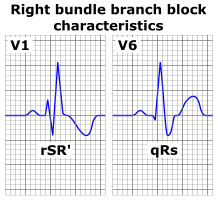Mitral stenosis
Mitral stenosis (MS) is the narrowing of the mitral valve zúžení (normally 4–6 cm2), almost exclusively post-rheumatic (usually associated with aortal stenosis), rarer causes are:
- innate mitral stenosis (after birth – it is operated on early),
- mitral anular calcification (in senium and presenium),
- systemic diseases of the connective tissue (skleroderma…),
- mucopolysaccharidosis,
- iatrogenic stenosis after valvuloplasty.
Patophysiology and the consequences[edit | edit source]
- The pressure gradient is rising between left atrium (LA) and left ventricle (LV),
- the pressure is rising in LA → hypertrophy of LA → dilation of LA → fibrilation of LA → blood stasis and trombosis – systemic embolisation,
- postcapillary pulmonary hypertension → pulmonary edema → shortness of breath,
- mixed pulmonary hypertension – active vasoconstriction of arteriols, fixation of the pulmonary hypertension,
- strain of the right ventricle (RV) – tricuspidalisation of the defect (hypertrophy of RV).
Symptoms[edit | edit source]
- exertional dyspnea hemoptosis, cough while physical activity,
- systemicembolisation (need of use of warfarin even in asymptomatic patients),
- paroxysms fibrilation of LA,
- secondary right sided insufficiency (edema, hepatomegaly, meteorisms, cachexia).
The first symptom is tiredness, then proprogressive exertional dyspnea, LA starts to dilatate, threat of fibrilation of atriums and a formation of an atrium trombus - threat of systemic embolisation (into CNS, limbs …), facies mitralis (red-purple cheeks with small capillaries), pulmonary edema (from postcapillary pulmonary hypertension), later později „trikuspidalisation of the defect“ (from fixated precapillary pulmonary hypertension and secondary rightsided heart insufficiency) - trias of rightsised heart insufficiency.
Physical finding[edit | edit source]
Auskultation trias[edit | edit source]
- Modificated I. heart sound – accented, amplified, corresponds to the closure of the mitral valve under high tension,
- II. heart sound – is followed by a mitral opening sound in early diastole („opening snap“), when the balloon-shaped stenotic valve can no longer open in diastole and vibrates
- the mitral opening sound is followed by a mesodiastolic-presystolic 'humming murmur the mitral opening sound is followed by a mesodiastolic-presystolic 'humming
We listen with a bell stethoscope, amplification can be achieved by exercising, in the position on the left side (amplifies). While listening, it resembles the call of the quail "five money".
In tricuspidation (tj. hypertrophy and dilation of right ventricle) arises:
- relative pulmonary regurgitation – Graham Steel´s diastolic murmur ,
- relative tricuspidal regurgitation – systolic murmur
These murmurs in right side of the heart increase in inspiration ( increased negative intrathoracic pressure, increased venous return into the right atrium) – River´s sign.
Examination[edit | edit source]
- Sciagram of the thorax – mitral shape of heart– enlargement of the left atrium (in lateral projection carina is pushed up), dilation of RA and RV (they are pushed forward, heart shadow is ushed to the left).
- EKG: P mitrale (doublepeaked, promising wave P in II, III, aVF), later fibrilation of the atriums, hypertrophy of right ventricle, eventually blockade of the right bundle branch.
- assessment of the mitral estuary area(norm. 4–6 cm2, stenosis under 2 cm2, very tight under 1 cm2),
- katetrisation:
- assesment of the pressure gradient LA – LV (transseptally or the wedge pressure),
- pressure measurement in the pulmonary circuit,
- assesment of MSV and estuary area calculation by Gorlin´s equation,
- echocardiography:
- morfology of the valve, Doppler (speed determination – and then pressure),
- size of LA and trombus presence (transesophageal ECHO),
- stge of tricuspidalisation.
Differencial diagnosis.[edit | edit source]
It´s necessary to differentiate diastolic murmur from Austin Flint murmur inaortal regurgitation, where the regurgitating blood flow from aorta shuts close prematurely and relatively stenosing the mitral valve – puts the front flap of the mitral valve in the way in a diastolic phase of the left ventricle, no mitral opening sound can be heard. Also by obstructing the mitral estuary by a bigtrombus LA or myxom.
Treatment[edit | edit source]
- Medicinal – warfarin (even in u asymptomatic patients), β-blockers, antiarrhythmics in atrium fibrilation,
- baloon mitral valvuloplasty,
- mitral valve replacement by prosthesis (in this case synthetic prosthetics are better than bioprosthesis),
- commissurotomy.
Prophylaxis[edit | edit source]
- Primary – early diagnosis and treatment of all streptococcal infections,
- secondary – after rheumatic fever - dispensarization and long-term administration of PNC.
Video – Summary of mitral defects[edit | edit source]






